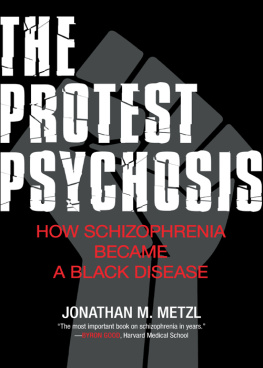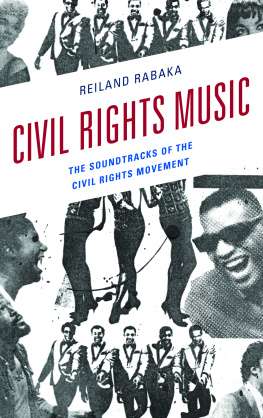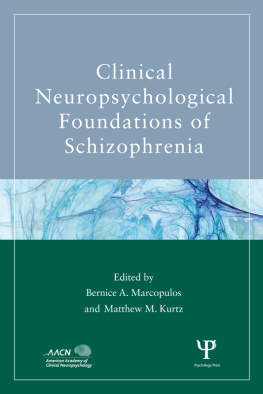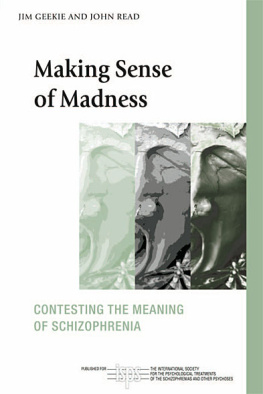
MORE PRAISE FOR
The Protest Psychosis
Jonathan Metzl offers a richly textured story of the confluence of race, psychiatric diagnoses, and social upheaval. The result is an absorbing account of how schizophrenia became a highly racialized label.
EARL LEWIS , author of Love on Trial and To Make Our World Anew, and provost, Emory University
The Protest Psychosis is the most important book on schizophrenia in years. Jonathan Metzl shows how schizophrenia was transformed from a largely white, middle-class, nonmenacing disorder to one that is widely perceived as dangerous and threatening, precisely at the time of the U.S. civil rights movement. Metzl demonstrates convincingly that fears associated with urban violence and the rise of black power in the 1960s became an essential part of the very definition of schizophrenia.
BYRON GOOD , author of Medicine, Rationality, and Experience and professor of medical anthropology, Harvard Medical School
The Protest Psychosis offers a compelling and expertly crafted study of the ways in which racial tensions are structured into medical interactions and shape its disease categories. This innovative historical portrait of the interaction of race and medicine should provoke deep reflection on how racial meanings become attached to docility, rage, and aggression, and become reified in psychiatric nomenclature and practice.
KEITH WAILOO , author of Dying in the City of the Blues: Sickle Cell Anemia and the Politics of Race and Health
In this riveting book, Jonathan Metzl anatomizes the ways in which social forces, cultural anxieties, and political protests shaped schizophrenia as a black disease. The story that emerges is fascinating and heartbreaking from the first word to the last.
EMILY MARTIN , author of Bipolar Expeditions: Mania and Depression in American Culture
The Protest Psychosis is an incisive and unexpectedly riveting book, equal parts medical history, social criticism, and investigative journalism. A very impressive work of scholarship.
CARL ELLIOTT , author of Better than Well: American Medicine Meets the American Dream

To Rumpa
PREFACE
The Protest Psychosis
THIS BOOK TELLS THE STORY of how race gets written into the definition of mental illness. It uncovers the surprising ways anxieties about racial differences shape clinical encounters, even when the explicit races of doctors and patients are not at issue. The book also shows how historical concerns about racial protest reverberate through treatment institutions and subvert even well-intentioned efforts to diagnose people or to help them. Ultimately, the book explores the processes through which American society equates race with insanity; and through which our definitions of both terms change as a result.
It is well known, of course, that race and insanity share a long and troubled past. In the 1850s, American psychiatrists believed that African American slaves who ran away from their white masters did so because of a mental illness called drapetomania. Medical journals of the era also described a condition called dysaesthesia aethiopis, a form of madness manifest by rascality and disrespect for the masters property that was believed to be cured by extensive whipping. Even at the turn of the twentieth century, leading academic psychiatrists shamefully claimed that Negroes were psychologically unfit for freedom.
We have undoubtedly progressed since that time. Terms such as drapetomania fill the dustbin of history, and rightly so. Yet, in unintended and often invisible ways, psychiatric definitions of insanity continue to police racial hierarchies, tensions, and unspoken codes in addition to separating normal from abnormal behavior. Sometimes, the boundaries of sanity align closely with the perceived borders of the racial status quo. Mainstream culture then defines threats to this racial order as a form of madness that is, still, overwhelmingly located in the minds and bodies of black men. At other times, members of minority communities use the language of insanity to describe the psychical effects of living in racist societies. In these instances and others, questions of who is mentally ill and why orbit around American race relations and their discontents. And seemingly hermetic clinical encounters between psychiatrists and patients unconsciously mirror larger conversations about the politics of race.
As a beginning illustration of the books main point, consider a prominent story that appeared on the front page of the Washington Post on June 28, 2005. Racial Disparities Found in Pinpointing Mental Illness read the headline. The article detailed a discovery that was at once shocking and sadly familiar. Researchers had examined the largest American registry of psychiatric patient records looking for ethnic trends in schizophrenia diagnoses. As the Post described it, schizophrenia, a disorder that often portends years of powerful brain-altering drugs, social ostracism and forced hospitalizations...has been shown to affect all ethnic groups at the same rate. And yet, the large government study uncovered striking categorical differences in its analysis of 134,523 case files: doctors diagnosed schizophrenia in African American patients, and particularly African American men, four times as often as in white patients. The Post cited the studys lead author, John Zeber, who explained that doctors overdiagnosed schizophrenia in African American men even though the research team uncovered no evidence that black patients were any sicker than whites, or that patients in either group were more likely to suffer from drug addiction, poverty, depression, or a host of other variables. According to Zeber, the only factor that was truly important was race.
Paradoxically, we live in an era when the opposite is supposed to be the case: race should be entirely unimportant to psychiatric diagnosis. Present-day psychiatry believes that mental illness results from disordered brain biology at levels that are presumably the same in people of all races and ethnic backgrounds. And psychiatrists consider schizophrenia to be the most biologically based of the mental illnesses. Leading journals routinely attribute symptoms of the illnessofficially defined as delusions, hallucinations, disorganized speech, disorganized or catatonic behavior, or so-called negative symptoms such as affective flatteningto defects in specific brain structures, peptides, or neurotransmitters. Articles that describe research into the causes of the illness thus carry titles such as Conserved Regional Patterns of GABA-Related Transcript Expression in the Neocortex of Subjects with Schizophrenia or, incredibly, Smaller Nasal Volumes as Stigmata of Aberrant Neurodevelopment in Schizophrenia. Meanwhile, textbooks routinely claim that, as a biological disorder, schizophrenia is an illness that should occur in 1 percent of any given population, or one out of every hundred persons regardless of where they live, how they dress, who they know, or what type of music they happen to prefer.
Yet, in the real world, 1 percent is a delusion. Not only do stories such as the Post article appear with regularitythey persist over time. In the 1960s, National Institute of Mental Health studies found that blacks have a 65% higher rate of schizophrenia than whites. In 1973, a series of studies in the
Next page











